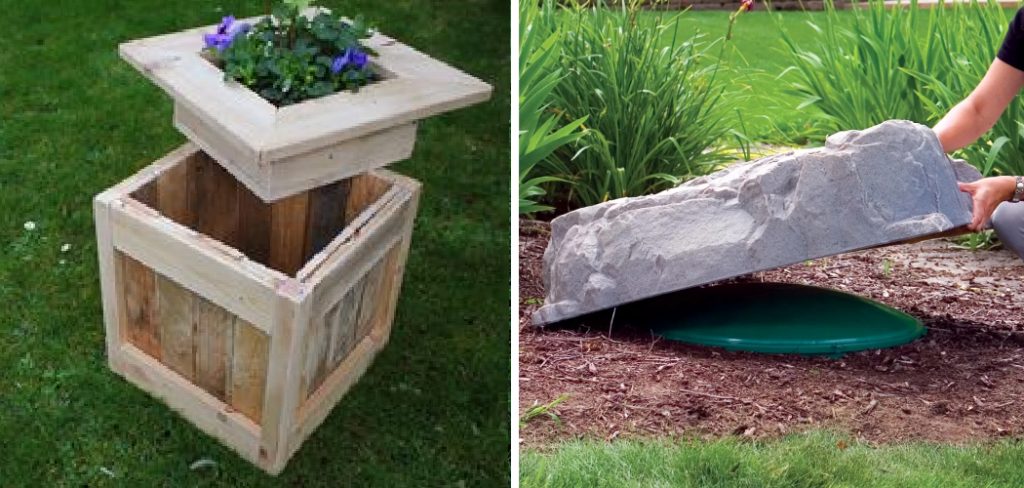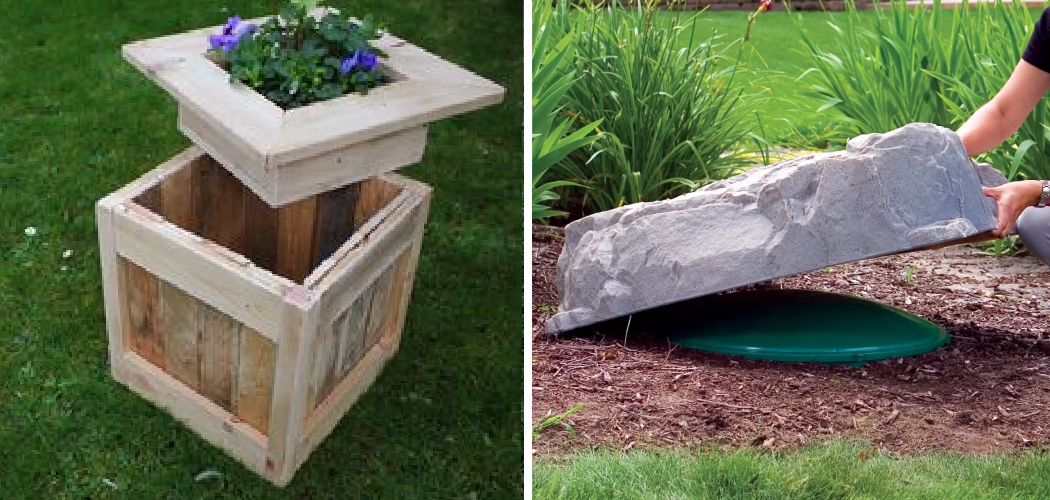Hiding septic tank risers is essential for property owners who wish to enhance the aesthetic appeal of their yards while also considering property value. Visible risers can detract from the overall appearance of a landscape, creating an unsightly focal point that may lower the desirability of a home.

Homeowners can maintain a neat and inviting outdoor space by concealing these risers. This article will provide various methods on how to hide septic tank risers, focusing on landscaping solutions that incorporate plants and mulch, decorative covers that blend with the environment, and strategic placement to ensure accessibility while minimizing visibility.
Each method aims to help homeowners balance functionality and beauty, ensuring that their septic systems are efficient and discreet.
Understanding Septic Tank Risers
What is a Septic Tank Riser?
A septic tank riser is a vertical extension that connects the septic tank lid to ground level, facilitating easier access for maintenance and inspections. Typically made from durable materials like plastic or concrete, risers are designed to withstand environmental conditions while providing a secure opening to the tank.
By elevating the access point, septic tank risers eliminate the need for extensive digging, thereby reducing the time and effort required to service the tank. This accessibility is crucial for regular pumping and inspections, ensuring that he septic system functions efficiently.
Why Hide Risers?
Homeowners may wish to hide septic tank risers for several reasons. Aesthetically visible risers can be unsightly and disrupt the natural beauty of a landscaped yard, detracting from the property’s overall appearance. Concealing these structures improves visual appeal and protects the risers from potential damage caused by weather, lawn maintenance, or foot traffic.
Additionally, hiding the risers can enhance the landscape by integrating them into the natural environment through strategic planting or decorative features, ultimately contributing to a more harmonious outdoor space.

How to Hide Septic Tank Risers: Landscaping Solutions
Step 1: Use of Groundcover Plants
One effective method for disguising septic tank risers is by planting groundcover plants, such as creeping thyme or clover. These low-growing plants spread quickly, creating a lush carpet that blends seamlessly into the landscape. When planting, ensure the soil is well-drained and incorporate organic matter to promote growth.
Regular watering is essential during the initial establishment phase, and occasional trimming may be required to keep the plants neat and tidy. Additionally, groundcover plants can attract beneficial pollinators, enhancing the overall ecological balance in your yard.
Step 2: Incorporate Decorative Rocks or Mulch
Using decorative rocks, gravel, or mulch can effectively cover the area around the riser while maintaining an attractive appearance. These materials come in various colors and sizes, allowing you to choose options that complement the existing landscape design.
When applying mulch or gravel, ensure a sufficient thickness for visual appeal while permitting easy access to the riser when necessary. Consider installing a border around the area to prevent erosion and maintain stability. Regular maintenance involves replenishing mulch or rearranging rocks as needed to sustain the desired look.
Step 3: Create a Raised Garden Bed
Building a raised garden bed around the septic tank riser can offer an attractive and functional concealment option. Start by selecting rot-resistant materials such as cedar or composite boards to construct the frame, ensuring it is at least 12 inches high for adequate soil depth.
Position the bed directly over the riser with ample space for access. Fill the bed with quality soil and select flowers or shrubs that thrive in your local climate while remaining manageable in height. This design not only hides the riser but also provides a vibrant splash of color and life, enhancing the overall aesthetic of your yard.

How to Hide Septic Tank Risers: Decorative Covers and Enclosures
Step 1: Install a Decorative Cover
A great way to hide septic tank risers is by installing a decorative cover that seamlessly blends into the landscape. Options range from custom-made covers, which can be tailored to fit specific dimensions and designs, to pre-fabricated covers available in various styles and materials.
When selecting a cover, consider factors such as color, texture, and pattern to ensure it complements your outdoor aesthetic while remaining functional. It’s crucial to choose a durable cover that can withstand the elements, including wind and rain, while still providing easy maintenance access.
Step 2: Build a Small Fence or Screen
Constructing a small fence or screen around the septic tank riser is another effective concealment method. Using wood or vinyl, create a stylish barrier that allows for easy access when maintenance is required. Start by measuring the area around the riser, ensuring the fence is tall enough to obscure the view without sacrificing accessibility.
You can build a simple picket fence or a more ornate lattice design to match your landscape style. Ensure that the posts are securely anchored and that any gates or openings provide adequate space for accessing the riser as needed.
Step 3: Use a Camouflage Box
Camouflage boxes or enclosures specifically designed to hide septic tank risers can also provide a smart solution. When choosing a camouflage box, select one that matches the environmental context—like a wooden box that complements surrounding features or a stone-textured material for a natural look.
Ensuring the box is the right size is essential, allowing it to cover the riser while permitting easy access for any maintenance work. Additionally, opt for a durable design that can withstand the elements, offering both aesthetic appeal and functionality.
Strategic Placement and Maintenance
Step 1: Choose an Appropriate Location
When selecting a location for the septic tank riser, opt for areas in the yard that are less conspicuous, such as behind larger landscaping features like shrubs, trees, or garden beds. Placing the riser near utility structures can also help minimize its visibility while ensuring it remains accessible for necessary maintenance.
It’s crucial to balance concealment with accessibility; the riser must be easy to reach for regular inspections and pumping without compromising the overall aesthetic of the landscape. Planning ahead will enhance your yard’s visual appeal while maintaining your septic system’s functionality.

Step 2: Regular Maintenance
Regular maintenance of the surrounding area is essential to ensure the longevity and proper functioning of the septic tank riser concealment. Periodically check to ensure that any covers or landscaping features do not obstruct access to the riser or cause damage. This may involve trimming overgrown plants, relocating decorative elements, or adjusting the positioning of rocks or mulch.
Additionally, keeping the area clear of debris, such as fallen leaves or grass clippings, is crucial to preventing unwanted blockages and safeguarding the riser from potential harm. Taking these proactive steps will help maintain a harmonious balance between aesthetics and functionality.
Safety and Accessibility Considerations
Ensure Easy Access
Maintaining easy access to the septic tank riser is crucial for regular inspections and maintenance. When planning your concealment methods, always design with practicality in mind.
This means positioning plants, decorative features, or barriers in a way that allows for straightforward access to the riser without the need for excessive relocation or effort. A well-thought-out layout will enable efficient upkeep while providing a visually appealing landscape, balancing aesthetics and functionality.
Avoiding Obstructions
When selecting plants or building structures near the riser, be cautious of large or invasive species that could obstruct access or interfere with the septic system’s proper functioning.
Opt for low-maintenance plants with non-invasive root systems, and ensure any fencing or decorative elements are installed with ample clearance. Keeping the area around the riser unobstructed will help guarantee safe access for maintenance crews while protecting the integrity of your septic system.
When to Call a Professional
Complex Concealment Projects
If your concealment project involves intricate designs or significant landscaping alterations, it’s wise to seek professional assistance. Complex projects can pose challenges in maintaining proper access to the septic tank riser while achieving the desired aesthetic appeal.
Professionals can devise effective solutions that balance concealment with functionality, ensuring that your septic system remains easily accessible for regular maintenance.
Compliance with Regulations
Moreover, it’s crucial to ensure that any modifications or concealments adhere to local regulations. Consulting a professional can help you navigate these legal considerations, preventing any violations that could affect the functionality of your septic system.
Their expertise will ensure that your project meets all necessary guidelines, safeguarding both your investment and the integrity of your septic system in the long run.

Conclusion
In summary, there are several effective methods for how to hide septic tank risers, ensuring both aesthetic appeal and functional accessibility. Key techniques include using landscaping solutions such as shrubs and flowers, decorative covers that blend with the surroundings, and strategic placement to minimize visibility while allowing for easy access.
Readers need to choose a concealment method that aligns with their individual aesthetic preferences while considering the practicality of maintenance and inspections. Remember, striking a balance between concealment and functionality is vital, as it helps maintain the efficiency of your septic system.
By selecting the right approach and committing to regular upkeep, you can create a beautiful outdoor space that discreetly accommodates your septic tank riser.

